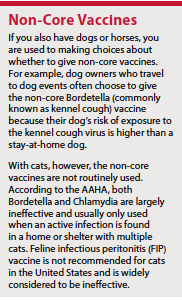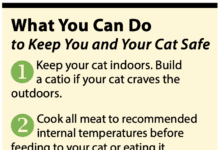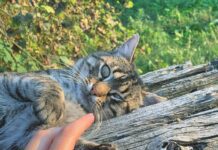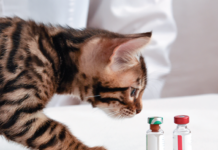Vaccines have played a huge role in the prevention of infectious diseases, both in humans and in animals, for hundreds of years. They’ve no doubt saved millions of lives and prevented great suffering along the way. But vaccines do not come with a 100% guarantee, and there are potential risks and side effects. These negatives, however, rarely outweigh the benefits of vaccines and their impact on well-being.
The goal of vaccination is to prevent a specific infection. Additionally, many vaccines, if not 100% effective at preventing infection, will lessen the severity of illness in the face of infection. This is a beneficial outcome of vaccination, as suffering is limited, recovery time is faster, and the spread of disease in a population is minimized.
Another purpose for vaccinating animals is to avoid the transmission of zoonotic diseases from animals to humans. Rabies, a devastating viral disease that is routinely fatal once symptoms arise, is a perfect example. Your cat can get rabies, and you can get it from your cat. Avoiding a vaccine due to fear of side effects is not worth the risk of transmitting the disease.
Choosing a Vaccine
Feline vaccines are either core or non-core. Core vaccines are recommended by the American Animal Hospital Association (AAHA) for all cats. Non-core vaccines are considered on an individual basis (see sidebar). So which vaccines are right for your cat?
“Vaccines play a critical role in the prevention of disease, but there are always questions about which vaccines are essential for cats,” says Elizabeth Dole, DVM, Cornell Class of ’86 and Diplomate of the American Board of Veterinary Practitioners. “The 2022 AAHA Feline Vaccination Guidelines, prepared by a task force of experts, is the most up-to-date resource.”
Three significant recommendations from the recently updated guidelines for all cats are:
1. Kittens need to receive the core Panleukopenia/Feline Herpesvirus/Calicivirus (FPV/FHV/FCV) vaccine every three to four weeks beginning at 6 to 8 weeks of age until they are at least 16 weeks old (12 weeks was historically considered sufficient). Boosting out to 16 weeks is important due to the potential interference with response to vaccination from maternally derived antibodies, which wane over time.
2. Consider an initial booster of the FPV/FHV/FCV vaccine at 6 months of age, rather than at 1 year of age, to decrease the potential window of susceptibility for developing illness if the kitten still had maternally derived antibodies at the time of the last initial kitten vaccine series. Boost these vaccines every three years thereafter.
3. The feline leukemia virus (FeLV) vaccine is now considered a core vaccine for kittens and young adult cats under 1 year of age due to age-related susceptibility to this devastating and potentially fatal disease. This is true even if they don’t go outdoors.
Putting It All Together
FPV/FHV/FCV: Kittens can start their FPV/FHV/FVC vaccination (this is the one you may know of as the “distemper-respiratory” vaccine) series at 6 weeks of age and finish at 16 to 20 weeks old. After their first annual booster as adults, this vaccine is then recommended every three years for life. Pregnant cats should not be vaccinated due to the possibility of birth defects in the kittens.
know of as the “distemper-respiratory” vaccine) series at 6 weeks of age and finish at 16 to 20 weeks old. After their first annual booster as adults, this vaccine is then recommended every three years for life. Pregnant cats should not be vaccinated due to the possibility of birth defects in the kittens.
Rabies: Rabies vaccination is recommended for all cats due to the extreme hazard rabies poses to humans. The type of rabies vaccine used in cats is important. While there is conflicting information regarding the safety of the two types of rabies vaccines available (recombinant vs inactivated), many practitioners believe the recombinant vaccines are safer for cats, particularly due to the possibility of feline injection site sarcoma (FISS), a potentially devastating side effect of vaccination. (Recombinant vaccines are produced using DNA technology. Inactivated vaccines contain a killed virus.)
FeLV: Cats and kittens should always be tested for FeLV before vaccination. While the vaccine won’t hurt an FeLV positive cat, it won’t help either.
Kittens can start the FeLV vaccination series at 8 weeks of age. The initial series involves two doses, three to four weeks apart. The next booster is recommended one year later.
After this, cats who stay strictly indoors and do not live with an FeLV positive cat have negligible risk of FeLV infection, which is spread by direct contact with infected blood, urine or saliva, making vaccination unnecessary. For cats who go outdoors, annual vaccination is recommended.
Side Effects and Reactions
Fortunately, severe vaccine reactions like anaphylaxis (life-threatening immune-mediated shock) are rare in cats. An anaphylactic reaction typically happens within minutes of receiving the vaccine, so your cat will usually still be at the veterinary clinic to receive emergency treatment in the event of anaphylaxis.
For cats who do have a reaction, most experience mild symptoms, where they generally don’t feel well, showing decreased appetite, lethargy, and hiding. This usually lasts less than 24 hours and typically does not require treatment.
Moderate reactions include persistent vomiting and/or diarrhea, facial swelling, hives, and itchiness. This type of reaction warrants a trip back to the veterinarian for evaluation and treatment.
FISS is a malignant tumor that is thought to be caused by inflammation associated with injections and the introduction of foreign materials into cats, including vaccines. Fortunately, it’s not common, but when it happens, it is usually bad. This phenomenon is the reason veterinarians stopped administering vaccines in the nape of the neck and started giving them in a lower limb. Some veterinarians use the tail, although this can be difficult. The logic is that, if an injection-site sarcoma forms, limb (or tail) amputation can be performed and potentially be curative. Adjuvant is an ingredient added to inactivated (killed) vaccines to increase their potency. Some evidence suggests a possible link between vaccines with an adjuvant and FISS, which is why most practitioners favor recombinant or modified live, non-adjuvanted vaccines for cats. This remains controversial.
Bottom Line
It’s always better to prevent disease when possible than to have to treat it. Vaccines are an important aspect of feline preventive health care, but not all vaccines are right for all cats. You and your veterinarian should do an individualized risk:benefit assessment for your cat to decide on an appropriate vaccination protocol.




